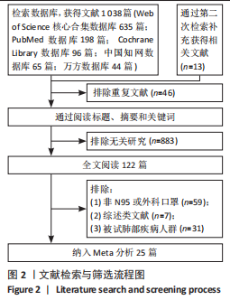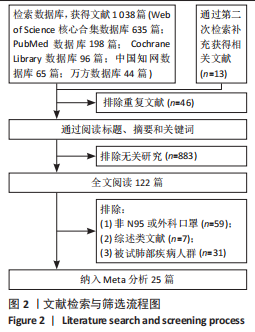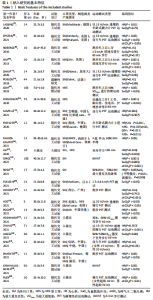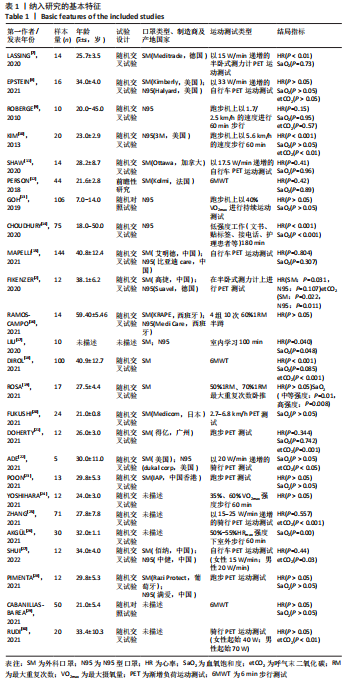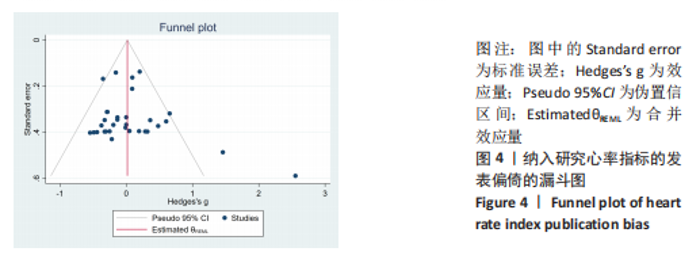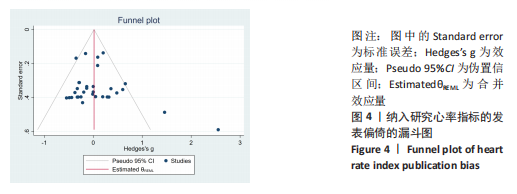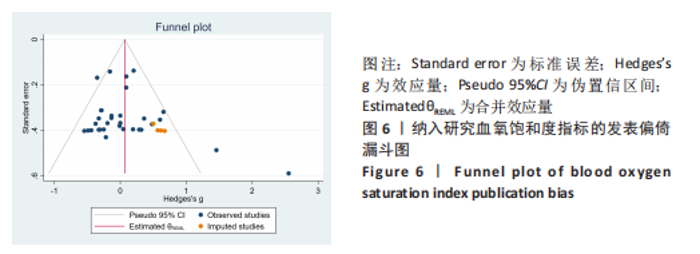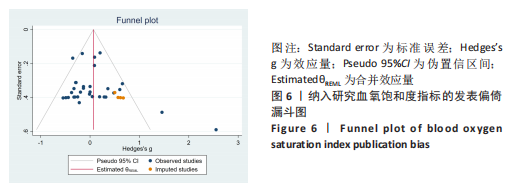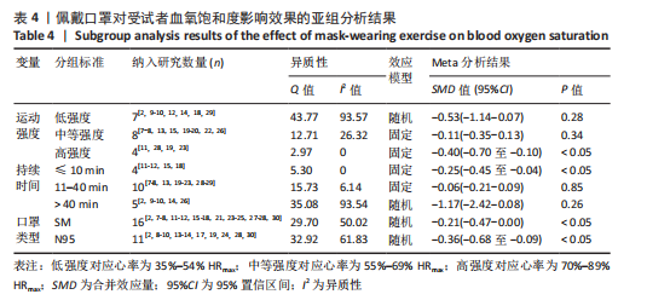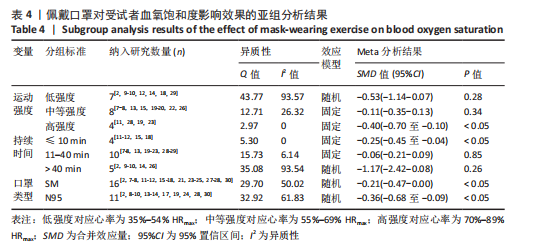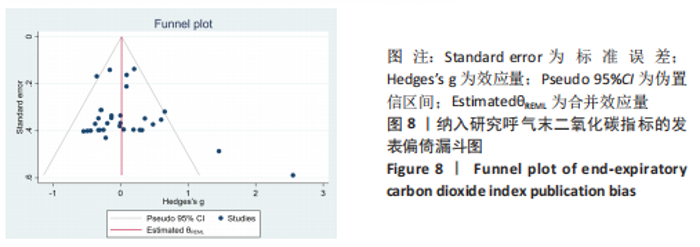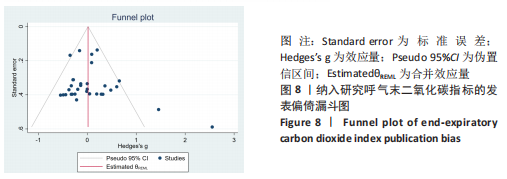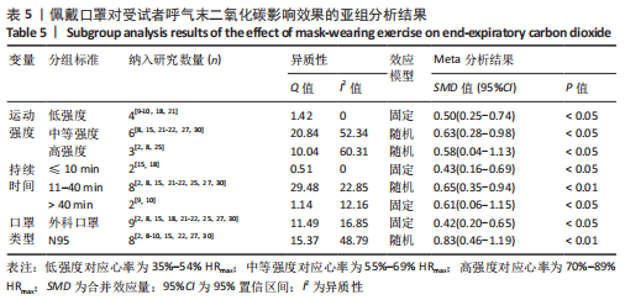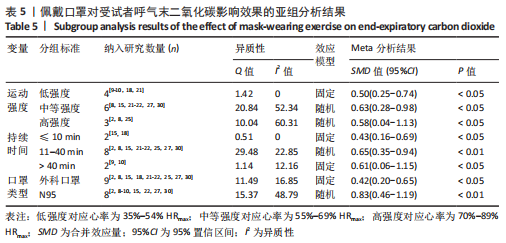Chinese Journal of Tissue Engineering Research ›› 2024, Vol. 28 ›› Issue (14): 2290-2296.doi: 10.12307/2024.279
Effects of mask-wearing exercise on heart rate, blood oxygen saturation and end-expiratory carbon dioxide: a Meta-analysis
Dai Xinyu1, Yan Jihong2, Bi Xuecui1, Zheng Xiaohong1
- 1Capital University of Physical Education and Sports, Beijing 100191, China; 2Physical Education Institute, Jishou University, Jishou 416000, Hunan Province, China
-
Received:2023-02-22Accepted:2023-04-06Online:2024-05-18Published:2023-07-28 -
Contact:Zheng Xiaohong, PhD, Professor, Doctoral supervisor, Capital University of Physical Education and Sports, Beijing 100191, China -
About author:Dai Xinyu, PhD candidate, Capital University of Physical Education and Sports, Beijing 100191, China -
Supported by:Scientific Research Fund Project of Liaoning Provincial Department of Education, No. WJC2020ST06 (to DXY)
CLC Number:
Cite this article
Dai Xinyu, Yan Jihong, Bi Xuecui, Zheng Xiaohong. Effects of mask-wearing exercise on heart rate, blood oxygen saturation and end-expiratory carbon dioxide: a Meta-analysis[J]. Chinese Journal of Tissue Engineering Research, 2024, 28(14): 2290-2296.
share this article
Add to citation manager EndNote|Reference Manager|ProCite|BibTeX|RefWorks
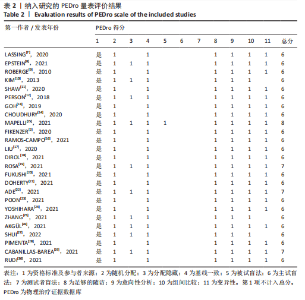
2.3 纳入研究的干预特征 25篇纳入文献均报道了口罩的型号、材质及用途,纳入文献中涉及恒定强度运动、递增强度运动和抗阻运动,其中恒定强度运动包括6 MWT、1.7 km/h的步行和2.5 km/h的步行;递增强度运动包括跑步、功率自行车、测功仪运动;抗阻运动主要包括器械或克服自身体质量的力量练习。运动时间6-180 min,其中最常用的为递增负荷运动测试。 2.4 纳入文献质量评价结果 在纳入的25项研究中,PEDro量表的得分为6-8分,平均6.16分,整体研究质量较好,见表2。研究被试纳入条件明确,被试能够按分配方案完成试验,测量报告比较完整,由于试验组均采取口罩进行干预,24项研究未能实现对测试者施盲。"
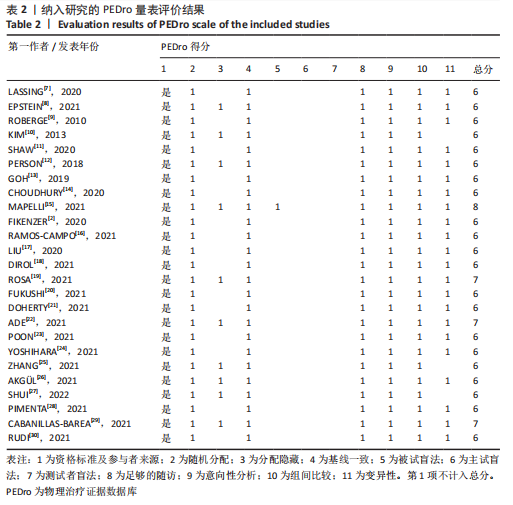
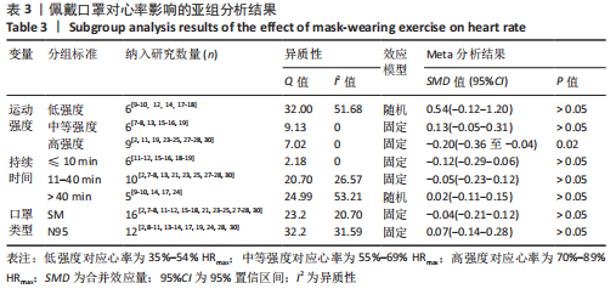
为了进一步探讨潜在异质性来源,对潜在调节变量进行亚组分析结果见表3。按运动强度进行分析,低强度组的异质性检验结果显示,研究间存在较高异质性,采用随机效应模型统计合并效应量,差异无显著性意义,表明佩戴口罩进行低强度运动,不会对心率产生负面作用;中等强度组的研究间存在低异质性,采用固定效应模型合并效应量,结果无显著性意义;高强度组的研究间不存在异质性,采用固定效应模型合并效应量,结果具有显著性意义,表明佩戴口罩进行高强度运动,会对心率产生负面作用;按照持续时间进行亚组分析,≤10 min运动组异质性检验结果显示,佩戴口罩进行短时间运动不会对心率产生负面影响;11-40 min运动组的异质性检验结果显示,研究间存在低度异质性,采用随机效应模型合并效应量,结果无显著性意义。> 40 min运动组异质性检验结果显示,研究间存在高度异质性,采用随机效应模型统计合并效应量,差异无显著性意义。"
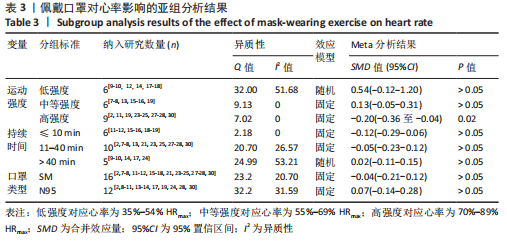

2.5.2 佩戴口罩对受试者血氧饱和度的影响 共19项研究以血氧饱和度为结局指标并报告了佩戴口罩运动对于该指标的影响[7-15,17-23,22,26,29],见图5。异质性检验发现研究间存在高度的异质性(I2=96.41 > 50%,P=0.00),敏感性分析逐一剔除纳入研究,发现血氧饱和度指标的异质性主要来自LIU等[17] 和AKGüL等[26]的研究,剔除该研究后异质性降低(Q=24.98,I2=2.97%),且效应量方向无变化。Egger检验结果(P=0.025)与漏斗图均提示了存在着非常显著的发表偏倚,见图6,用剪补法对发表偏倚进行校正后效应值略有降低,但方向并未发生变化,其效应量值为-0.13(95%CI:-0.24至-0.02)。"
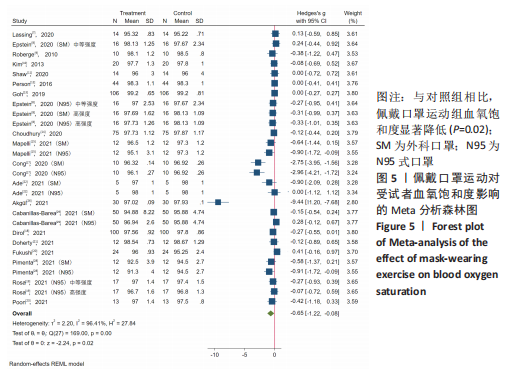
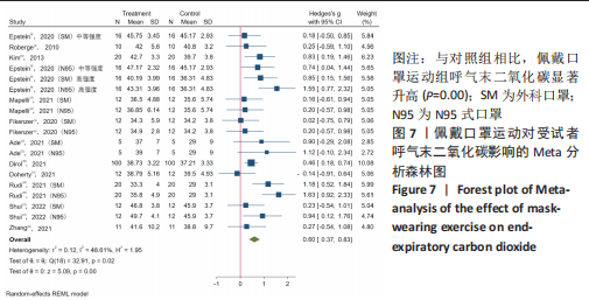
2.5.3 佩戴口罩对受试者呼气末二氧化碳的影响 共9项研究以呼气末二氧化碳为结局指标并报告了佩戴口罩运动对于该指标的影响[2,8-10,18,21-22,27,30]。对其进行异质性检验发现研究间存在中度的异质性,选用随机效应模型合并结果。Meta分析结果如图7所示,合并SMD=0.60(95%CI:0.37-0.83,P=0.00),结果表明,佩戴口罩运动对呼气末二氧化碳的影响明显。Egger检验及漏斗图发现纳入研究存在明显的发表偏倚(P=0.00),见图8。为保证研究结果的可靠性,采用逐个排除的方法和固定效应模型与随机效应模型互换的方法进行敏感性分析,剔除RUDI等[30]的研究后,异质性显著下降(I2=0%,P=0.22),但效应量未见显著变化,研究结果可靠。"
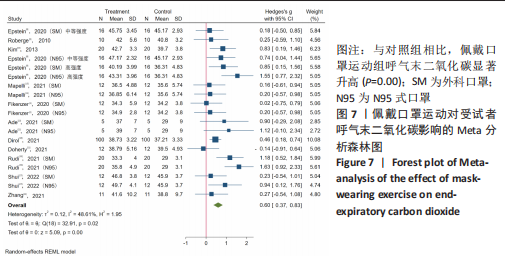

2.6 敏感性分析结果 为进一步探究文献异质性的来源,文章对血氧饱和度指标进行敏感性分析结果显示,剔除LIU等[17]和AKGüL等[26]中任一研究均会改变总效应量,详见表6;剔除上述研究后,异质性I2从96.62%降至2.77%,且试验组运动中血氧饱和度仍低于对照组,差异具有显著性意义。第1项研究中运动测试的持续时间较长、其运动场所为室外可能是异质性的原因,被试在运动测试起始时的血氧饱和度为97.78%-98.22%,运动末期降低至95.47%,试验组与对照组的差异虽有显著性意义,但该值并不代表人体出现了低血氧症。第2项研究以大学生为受试者进行了100 min的伏案工作测试。分析认为,伏案工作与运动区别较大,运动中的被试倾向于主动调整呼吸策略,采取“深而慢”的呼吸进行运动,而坐姿学习的受试者更倾向于采用常规的和相对表浅的呼吸方式,由此导致了肺泡通气量的降低。剔除导致异质性来源的研究后,结局指标合并结果未发生方向性转变,提示Meta分析结果稳定。虽然研究异质性客观存在,但未影响最终统计学结果,为反映研究真实性,在分析时仍保留相关研究,未进行排除。"

| [1] ZHENG C, POON ETC, WAN K, et al. Effects of wearing a mask during exercise on physiological and psychological outcomes in healthy individuals: a systematic review and meta-analysis. Sports Med. 2023;53(1):125-150. [2] SANTOS-SILVA PR, GREVE JMDA, PEDRINELLI A. During the coronavirus (covid-19) pandemic, does wearing a mask improve or worsen physical performance? Rev Bras Med Esporte. 2020;26(4):281-284. [3] FIKENZER S, UHE T, LAVALL D, et al. Effects of surgical and FFP2/N95 face masks on cardiopulmonary exercise capacity. Clin Res Cardiol. 2020;109(12):1522-1530. [4] CHANDRASEKARAN B, FERNANDES S. “Exercise with facemask; Are we handling a devil’s sword?” - A physiological hypothesis. Med Hypotheses. 2020;144(1):1-4. [5] 李清茹,王一帆,陈冠廷,等.细胞外囊泡治疗急性肾损伤临床前研究的Meta分析[J].中国组织工程研究,2023,27(24):3926-3936. [6] 赵海燕,王林霞,赵德峰,等.心率变异性指标RMSSD和TLHRV在持续性运动训练负荷监控中的有效性研究[J].中国运动医学杂志,2018,37(6):461-467. [7] LASSING J, FALZ R, POKEL C, et al. Effects of surgical face masks on cardiopulmonary parameters during steady state exercise. Sci Rep. 2020;10(1):1-9. [8] EPSTEIN D, KORYTNY A, ISENBERG Y, et al. Return to training in the COVID-19 era: The physiological effects of face masks during exercise. Scand J Med Sci Sports. 2021;31(1):70-75. [9] ROBERGE RJ, COCA A, WILLIAMS WJ, et al. Physiological impact of filtering facepiece respirator (‘N95 Masks’) use on healthcare workers. RESP CARE. 2010;55(5):569-577. [10] KIM JH, BENSON SM, ROBERGE RJ. Pulmonary and heart rate responses to wearing N95 filtering facepiece respirators. Am J Infect Control. 2013;41(1):24-27. [11] SHAW K, BUTCHER S, KO J, et al. Wearing of cloth or disposable surgical face masks has no effect on vigorous exercise performance in healthy individuals. Int J Environ Res Public Health. 2020;17(21):1-9. [12] PERSON E, LEMERCIER C, ROYER A, et al. Effect of a surgical mask on six minute walking distance. Revue des maladies respiratoires. 2018;35(3):264-268. [13] GOH DYT, MUN MW, LEE WLJ, et al. A randomised clinical trial to evaluate the safety, fit, comfort of a novel N95 mask in children. Sci Rep. 2019;9(1):1-10. [14] CHOUDHURY A, SINGH M, KHURANA DK, et al. Physiological effects of N95 FFP and PPE in healthcare workers in COVID intensive care unit: a prospective cohort study. Indian J Crit Care Med. 2020;24(12):1169-1173. [15] MAPELLI M, SALVIONI E, DE MARTINO F, et al. “You can leave your mask on”: effects on cardiopulmonary parameters of different airway protection masks at rest and during maximal exercise. Eur Respir J. 2021;58(1):1-10. [16] RAMOS-CAMPO DJ, PÉREZ-PIÑERO S, MUÑOZ-CARRILLO JC, et al. Acute effects of surgical and FFP2 face masks on physiological responses and strength performance in persons with sarcopenia. Biology. 2021;10(213):1-9. [17] LIU C, LI G, HE Y, et al. Effects of wearing masks on human health and comfort during the COVID-19 pandemic. IOP Conference Series: earth and Environmental Science. 2020;531(1):1-6. [18] DIROL H, ALKAN E, SINDEL M, et al. The physiological and disturbing effects of surgical face masks in the COVID-19 era. Bratisl Lek Listy. 2021;122(11):821-825. [19] ROSA BV, ROSSI FE, MOURA HPDSN, et al. Effects of FFP2/N95 face mask on low-and high-load resistance exercise performance in recreational weight lifters. Eur J Sport Sci. 2021;22(9):1326-1334. [20] FUKUSHI I, NAKAMURA M, KUWANA S. Effects of wearing facemasks on the sensation of exertional dyspnea and exercise capacity in healthy subjects. PLoS One. 2021;10(1):1-10. [21] DOHERTY C, MANN L, ANGUS SA, et al. Impact of wearing a surgical and cloth mask during cycle exercise. Appl Physiol Nutr Metab. 2021;46(7):753-762. [22] ADE CJ, TURPIN V-RG, PARR SK, et al. Does wearing a facemask decrease arterial blood oxygenation and impair exercise tolerance? Respir Physiol Neurobiol. 2021;12(294):1-16. [23] POON ET, ZHENG C, WONG SH. Effect of wearing surgical face masks during exercise: does intensity matter? Front Physiol. 2021;12(26):1-7. [24] YOSHIHARA A, DIERICKX EE, BREWER GJ, et al. Effects of face mask use on objective and subjective measures of thermoregulation during exercise in the heat. Sports Health. 2021;13(1):463-470. [25] ZHANG G, LI M, ZHENG M, et al. Effect of surgical masks on cardiopulmonary function in healthy young subjects: a crossover study. Front Physiol. 2021;12(1): 1-12. [26] AKGÜL MŞ, OZCAN N, UZUN ME, et al. Physiological impact of wearing a surgical face mask during walking in the COVID-19 pandemic. Pedagog Phys Cult Sport. 2021;25(1):202-207. [27] SHUI L, YANG B, TANG H, et al. Physiological effects of surgical and N95 masks during exercise in the Covid-19 era. Am J Med Sci. 2022;363(1):411-419. [28] PIMENTA T, TAVARES H, RAMOS J, et al. Facemasks during aerobic exercise: implications for cardiac rehabilitation programs during the Covid-19 pandemic. Rev Port Cardiol. 2021;40(1):957-964. [29] CABANILLAS-BAREA S, RODRÍGUEZ-SANZ J, CARRASCO-URIBARREN A, et al. Effects of using the surgical mask and FFP2 during the 6-min walking test. A randomized controlled trial. Int J Environ Res Public Health. 2021; 18(23):1-16. [30] RUDI WS, MAIER F, SCHÜTTLER D, et al. Impact of face masks on exercise capacity and lactate thresholds in healthy young adults. Int J Sports Physiol Perform. 2021;1(1):1-4. [31] GARRA GM, PARMENTIER D, GARRA G. Physiologic effects and symptoms associated with extended-use medical mask and N95 respirators. Ann Work Exp Health. 2021;65(7):862-867. [32] HARAF RH, FAGHY MA, CARLIN B, et al. The physiological impact of masking is insignificant and should not preclude routine use during daily activities, exercise, and rehabilitation. J Cardiopulm Rehabil Prev. 2021;41(1):1-5. [33] 王力翔,刘兴会,唐小燕,等.SARS-CoV-2“后暴发”阶段医院感染控制[J].科学通报,2021,66(Z1):439-452. |
| [1] | Wang Yida, Liu Jun, Wang Xiaoling, Wang Liyan, Yang Chengru, Zhang Xuexiao. Effects of wearable electronic device-based interventions on physical activity and sedentary behavior in healthy adolescents: a meta-analysis [J]. Chinese Journal of Tissue Engineering Research, 2025, 29(8): 1693-1704. |
| [2] | Zhang Zixian, Xu Youliang, Wu Shaokui, Wang Xiangying. Effects of blood flow restriction training combined with resistance training on muscle indicators in college athletes: a meta-analysis [J]. Chinese Journal of Tissue Engineering Research, 2025, 29(8): 1705-1713. |
| [3] | Wang Juan, Wang Guanglan, Zuo Huiwu. Efficacy of exercise therapy in the treatment of anterior cruciate ligament reconstruction patients: #br# a network meta-analysis #br# [J]. Chinese Journal of Tissue Engineering Research, 2025, 29(8): 1714-1726. |
| [4] | Zheng Huakun, Yin Mingyue, Liu Qian. Effects of interval and continuous training on the quality of life in physically inactive adults: a meta-analysis [J]. Chinese Journal of Tissue Engineering Research, 2025, 29(8): 1727-1740. |
| [5] | Wang Jianlei, He Peiliang, Sun Yongjian. A meta-analysis of clinical efficacy and safety of intravenous glucocorticoids before lower limb joint arthroplasty [J]. Chinese Journal of Tissue Engineering Research, 2025, 29(3): 599-607. |
| [6] | Li Jia, Liu Qianru, Xing Mengnan, Chen Bo, Jiao Wei, Meng Zhaoxiang. A network meta-analysis on therapeutic effect of different types of exercise on knee osteoarthritis patients [J]. Chinese Journal of Tissue Engineering Research, 2025, 29(3): 609-616. |
| [7] | Zhou Yanjie, Cao Chunfeng, Zhang Zhongzu, Niu Xiong, Wang Xin, Yang Zaihai, Zhou Liang, Li Bo. Meta-analysis of anterior cervical decompression and fusion ROI-CTM self-locking system in treatment of degenerative cervical spondylosis [J]. Chinese Journal of Tissue Engineering Research, 2025, 29(3): 617-627. |
| [8] | Zhong Jun, Wang Wen. Network meta-analysis of different anatomical repair strategies to improve chronic lateral ankle instability [J]. Chinese Journal of Tissue Engineering Research, 2024, 28(9): 1470-1476. |
| [9] | Ma Shuwei, He Sheng, Han Bing, Zhang Liaoyun. Exosomes derived from mesenchymal stem cells in treatment of animals with acute liver failure: a meta-analysis [J]. Chinese Journal of Tissue Engineering Research, 2024, 28(7): 1137-1142. |
| [10] | Zhang Zeyi, Yang Yimin, Li Wenyan, Zhang Meizhen. Effect of foot progression angle on lower extremity kinetics of knee osteoarthritis patients of different ages: a systematic review and meta-analysis [J]. Chinese Journal of Tissue Engineering Research, 2024, 28(6): 968-975. |
| [11] | Hu Zhixing, Li Qun, Yang Chao, Wang Xiaoxiao, Fang Luochangting, Hou Wuqiong, Lin Na, Chen Weiheng, Liu Chunfang, Lin Ya. Network meta-analysis of the modeling effects of different factors on rabbit models of steroid-induced osteonecrosis of femoral head [J]. Chinese Journal of Tissue Engineering Research, 2024, 28(6): 976-984. |
| [12] | Yu Zhaoyu, Tan Lixin, Sun Kai, Lu Yao, Li Yong. Meta-analysis of cement-augmented pedicle screw for thoracolumbar degenerative diseases with osteoporosis [J]. Chinese Journal of Tissue Engineering Research, 2024, 28(5): 813-820. |
| [13] | Abuduwupuer·Haibier, Alimujiang·Yusufu, Maihemuti·Yakufu, Maimaitimin·Abulimiti, Tuerhongjiang·Abudurexiti. Meta-analysis of efficacy and safety of terlipatide and bisphosphate in the treatment of postmenopausal osteoporosis fractures [J]. Chinese Journal of Tissue Engineering Research, 2024, 28(4): 639-645. |
| [14] | Bai Xiaotian, Chen Zhaoying, Song Yiling, Wang Ye, Liu Jingmin. Effect of minimalist shoes on foot muscle morphology: systematic evaluation and Meta-analysis [J]. Chinese Journal of Tissue Engineering Research, 2024, 28(4): 646-650. |
| [15] | Wang Juan, Wang Ling, Zuo Huiwu, Zheng Cheng, Wang Guanglan, Chen Peng. Rehabilitative efficacy of kinesio taping following anterior cruciate ligament reconstruction: a Meta-analysis [J]. Chinese Journal of Tissue Engineering Research, 2024, 28(4): 651-656. |
| Viewed | ||||||
|
Full text |
|
|||||
|
Abstract |
|
|||||
